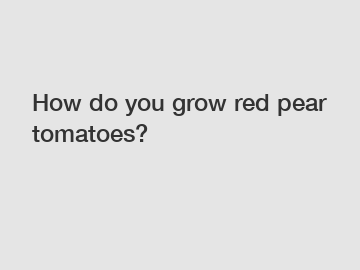How do you grow red pear tomatoes?
How do you grow red pear tomatoes?
Red pear tomatoes, also known as baby pear tomatoes, are a popular choice among gardening enthusiasts due to their sweet flavor and vibrant color. These petite tomatoes are perfect for snacking, salads, or as a beautiful addition to any dish. So, if you're wondering how to grow these delightful tomatoes in your own garden, here are some essential points to consider:
1. Selecting the Right Variety:

When it comes to growing red pear tomatoes, choosing the right variety is crucial. There are several options available, such as 'Red Pear,' 'Cherry Falls,' and 'Yellow Pear.' Consider factors like taste preference, plant size, and disease resistance before making a decision. Opt for varieties known for their vigorous growth and abundant production.
2. Preparing the Soil:
Red pear tomatoes thrive in loose, well-draining soil with a slightly acidic pH level between 6.0 and 6.8. Prepare the soil by removing any weeds, rocks, or debris that could hinder root growth. Incorporate organic matter like compost or well-rotted manure to boost the soil's fertility and moisture retention capacity.
3. Starting from Seeds:
Begin by starting your red pear tomato plants indoors approximately six to eight weeks before the last frost date in your region. Sow the seeds in seedling trays filled with a quality potting mix, ensuring they are placed about a quarter-inch deep. Mist the surface lightly with water and cover the tray with plastic wrap to create a greenhouse-like environment for germination.
4. Transplanting and Spacing:
Once the seedlings have developed true leaves and are around 6-8 inches tall, they are ready to be transplanted into the garden. Choose a sunny location that receives at least six hours of direct sunlight daily. Space the plants 18-24 inches apart to provide ample room for growth and airflow, reducing the risk of diseases.
5. Watering and Fertilizing:
Proper watering is crucial for the optimal growth of red pear tomatoes. Water the plants consistently, keeping the soil evenly moist but not waterlogged. Regularly monitor the moisture levels, especially during hot summer days. Applying organic mulch around the plants helps to retain moisture, suppress weeds, and maintain a more stable soil temperature.
Fertilize red pear tomato plants with a balanced fertilizer, high in phosphorus (the middle number on fertilizer labels), to promote healthy root development and fruit production. Follow the instructions on the fertilizer packaging, and refrain from over-fertilizing, as it can result in excessive foliage growth at the expense of fruits.
6. Pruning and Support:
Although optional, pruning can benefit red pear tomato plants by improving air circulation, reducing the risk of diseases, and directing energy towards fruit production. Remove suckers (the small shoots that form in the leaf axils) and any diseased or damaged branches. As the plants grow taller, provide support like cages or stakes to prevent sprawling and ensure the fruit remains off the ground.
7. Pest and Disease Management:
Keeping a close eye on potential pests and diseases is crucial to successfully growing red pear tomatoes. Common pests to watch out for include aphids, tomato hornworms, and whiteflies. Inspect plants regularly, and if any signs of infestation are spotted, take appropriate measures like using organic insecticides or introducing beneficial insects as a natural pest control method.
Common diseases that affect tomato plants include leaf spot, early blight, and blossom end rot. Minimize the risk by practicing crop rotation, providing adequate airflow between plants, and avoiding excessive overhead watering. If necessary, utilize organic fungicides to help combat these diseases.
Conclusion:
Growing red pear tomatoes can be a rewarding experience for any gardener. By following these essential tips, such as selecting the right variety, preparing the soil, starting from seeds, transplanting properly, and providing appropriate care, you'll be well on your way to enjoying the delicious taste of these vibrant, miniature tomatoes. Remember, regular maintenance, including watering, fertilizing, pruning, and pest/disease management, is essential for a successful harvest. So, why not step into your garden and start growing your own red pear tomatoes today?
Contact us to discuss your requirements of Vegetable Seed Wholesale Suppliers, wholesale vegetable seed, China Pumpkin Seeds Suppliers. Our experienced sales team can help you identify the options that best suit your needs.


